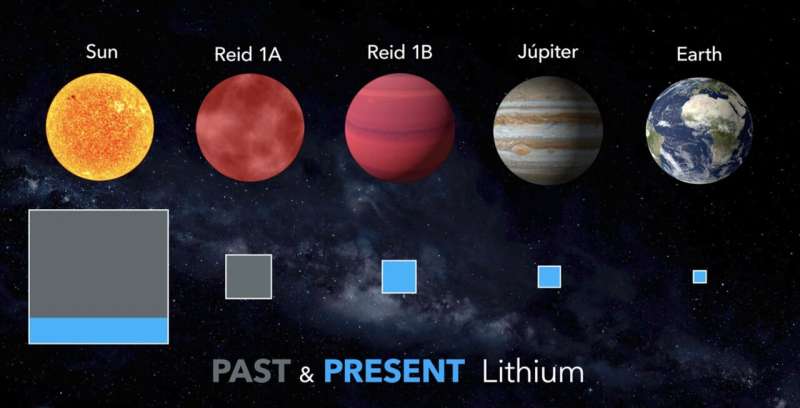Brown dwarfs, also known as "coffee colored dwarfs" or "failed stars" are the natural link between stars and planets. They are more massive than Jupiter but now sufficiently to burn hydrogen, which is the fuel the stars use to shine. For that reason these substellar objects were not observed until observers detected them in the mid 1990's. They are particularly interesting because it was predicted that some of them could preserve intact their content of lithium, sometimes known as "white petroleum" because of its rarity and its relevance.
In the past twenty years astronomers have detected, and followed the orbital motions of binaries formed by brown dwarfs in the solar neighborhood. They have determined their masses dynamically using Kepler's laws, the mathematical formulae produced in the XVII century by Johannes Kepler to describe the motions of astronomical bodies moving under the effects of their mutual gravitation, such as the system formed by the Earth and the Sun. In some of these systems the primary component has a mass sufficient to burn lithium while the secondary may not have this mass. However until now the theoretical models had not been put to the test.
Using the OSIRIS spectrograph on the Gran Telescopio Canarias (GTC, or Grantecan) currently the largest optical and infrared telescope in the world, at the Roque de los Muchachos Observatory (ORM), a team of researchers at the Instituto de Astrofísica de Canarias (IAC) and the Instituto Nacional de Astrofísica, Óptica y Electrónica (INAOE) made high sensitivity spectroscopic observations, between February and August this year, of two binaries whose components are brown dwarfs.
They did not detect lithium in three of them, but they did find it in Reid 1B, the faintest and coolest of the four. Doing this they made a remarkable discovery, a deposit of cosmic lithium which is not destroyed, whose origin dates back before the formation of the system to which Reid 1B belongs. It is, in fact, the coolest, faintest extrasolar object where lithium has been found, in a quantity 13 thousand times greater than the amount there is on Earth. This object, which has an age of 1.100 million years, and a dynamical mass 41 times bigger than that of Jupiter (the largest planet in the Solar System), is 16.9 light years away from us.
A chest of hidden treasure
Observations of lithium in brown dwarfs allow us to estimate their masses with a degree of accuracy, based on nuclear reactions. The thermonuclear masses found this way must be consistent with the dynamical masses found, with less uncertainty, from orbital analysis. However the researchers have found that the lithium is preserved up to a dynamical mass which is 10% lower than that predicted by the most recent theoretical models. This discrepancy seems to be significant, and suggests that there is something in the behavior of brown dwarfs that we still don't understand.
"We have been following the trail of lithium in brown dwarfs for three decades" says Eduardo Lorenzo Martín Guerrero de Escalante, Research Professor of the Higher Council for Scientific Research (CSIC) at the IAC who is the first author of the article, "and finally we have been able to make a precise determination of the boundary in mass between its preservation and its destruction, and compare this with the theoretical predictions." The researcher adds that "there are thousands of millions of brown dwarfs in the Milky Way. The lithium contained in brown dwarfs is the largest known deposit of this valuable element in our cosmic neighborhood."
Carlos del Burgo Díaz co-author of the article, a researcher at the INAOE, a public research center of the Mexican CONACYT, explains that "although primordial lithium was created 13.800 million years ago, together with hydrogen and helium, as a result of he nuclear reactions in the primordial fireball of the Big Bang, now there is as much as four times more lithium in the Universe." According to this researcher "although this element can be destroyed, it is also created in explosive events such as novae and supernovae, so that brown dwarfs such as Reid 1B can wrap it up and protect it as if it was a chest of hidden treasure."
The research was published in Monthly Notices of the Royal Astronomical Society.
Explore further



